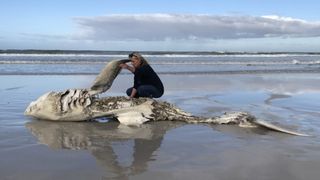Serial killer whales have been murdering sharks and eating their livers for 5 years
Two killer orcas, Port and Starboard, have slaughtered at least 8 great white sharks since 2015.

In the waters off of South Africa, a killer whale killing spree is raging.
Since 2017, a pair of male orcas (Orcinus orca) have slaughtered at least eight great white sharks (Carcharodon carcharias) near the Gansbaai coast, tearing the fearsome fish apart and eating their livers in all but one case. Some of the sharks — which scientists periodically find dead and shredded on nearby beaches — were even missing their hearts.
Such grisly displays aren't that unusual for orcas, which have been observed killing everything from tiny fish to burly sharks, sea lions and even blue whales. But rarely have the violent escapades of two individual whales had such a clear and immediate impact on their habitat, say the authors of a new study published Wednesday (June 29) in the African Journal of Marine Science.
According to the researchers, great white shark sightings have dropped dramatically in the area since the two serial killer cetaceans began their spree five years ago. Using a combination of long-term sightings and tagging data, the researchers found that dozens of sharks have been actively avoiding regions of the Gansbaai coast when the orcas are nearby. Tagged sharks sometimes disappeared for weeks or months at a time, abandoning territory that, historically, has been dominated by great whites.
"What we seem to be witnessing though is a large-scale avoidance strategy, mirroring what we see used by wild dogs in the Serengeti in Tanzania, in response to increased lion presence," lead study author Alison Towner, a senior biologist studying white sharks at the Dyer Island Conservation Trust in South Africa, said in a statement. "The more the orcas frequent these sites, the longer the great white sharks stay away."
Serial killer whales
Gansbaai is located about 75 miles (120 km) east of Cape Town. According to the study authors, a year-round great white shark presence in the area has made Gansbaai a popular tourist destination for shark watchers.
Reaching up to 16 feet (4.9 meters) in length and sporting several rows of up to 300 serrated, knife-like teeth, great whites are among the top predators in the water. But beginning in 2015, the sharks of Gansbaai met their match when a pair of mature male orcas descended on the coast.
Sign up for the Live Science daily newsletter now
Get the world’s most fascinating discoveries delivered straight to your inbox.
Like cartoon criminals, the orcas were easily identifiable by their battle scars; one whale's dorsal fin had collapsed to the right, while the other's bent to the left. These features inspired local whale watchers to nickname the orcas Port and Starboard. Nearly as soon as whale watchers spotted the duo at Gansbaai, a great white shark washed up dead on the beach.
Between 2016 and 2017, five more white sharks were found dead — four of them with their bodies torn open and their livers ripped out. (Unlike bony fishes, sharks have a very large, fatty liver, which could provide a lot of energy and nutrition to attackers, Live Science previously reported). Each shark's death corresponded with sightings of Port and Starboard in the area. While their official kill count is eight,, more undiscovered shark carcasses have likely been lost to the sea.
In the six months following the first shark's death, daily shark sightings at Gansbaai plummeted from over six sightings per day to just one. Detections of sharks tagged with electronic transmitters also dropped. Prior to the attacks in 2017, between three and eight tagged sharks were detected in the area each day. For several months after, that number dropped to zero. Transmitter data showed that individual sharks sometimes swam hundreds of miles away from Gansbaai within a few days of an orca attack. In some cases, sharks stayed away for six months or more before returning.
This mass shark migration has had downstream effects on the local ecosystem, the researchers said. Most noticeably, a new mid-level predator called the bronze whaler shark (Carcharhinus brachyurus) has moved into the area to take over the niche that great whites previously filled. These sharks are often preyed upon by great whites, but with the big guys gone, bronze whaler sightings have increased significantly, the researchers found. This shift could ripple down the entire food chain, putting pressure on the whole ecosystem, the team added.
What's driving this killer whale spree in the first place? Fierce as they are, orcas don't typically prey on great white sharks, the researchers said — however, scientists have observed a rare flat-toothed sub-species of killer whale in South Africa that seems to specialize in hunting sharks. It's possible that Port and Starboard belong to this group, the team wrote. The sudden appearance of orcas at Gansbaai could be "related to a decline in prey populations, including fishes and sharks, causing changes in their distribution pattern," Towner said.
Further observations of the whales and sharks of Gansbaai are needed to fully solve this ocean murder mystery.
Originally published on Live Science.

Brandon is the space/physics editor at Live Science. His writing has appeared in The Washington Post, Reader's Digest, CBS.com, the Richard Dawkins Foundation website and other outlets. He holds a bachelor's degree in creative writing from the University of Arizona, with minors in journalism and media arts. He enjoys writing most about space, geoscience and the mysteries of the universe.
